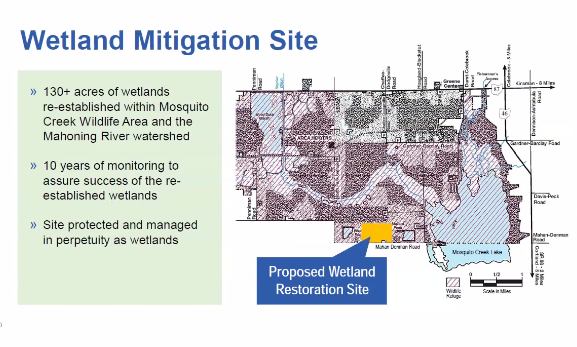Public Comment Period Open for GM-LG Battery Plant
YOUNGSTOWN, Ohio – The joint venture General Motors-LG Chem battery plant in Lordstown will be 2.5 million square feet – the equivalent of 31 football fields – and will drive toward an all-electric future with 100% renewable energy in operations, Plant Manager Tom Gallagher said Thursday evening during an online meeting hosted by U.S. Army Corps of Engineers Pittsburgh District and Ohio Environmental Protection Agency.
The virtual meeting was a quick replacement to a scheduled in-person public meeting at Lordstown High School that was canceled due to the coronavirus pandemic.
“It does not really meet the standards of a public hearing, but the intent of this was to really get comments from the public on the proposed project,” said Scott Hans, chief regulatory division, Corps of Engineers, adding that questions submitted via the chatroom will become part of the official review.
Gigapower LLC – the working legal name for the GM-LG venture expected to create 1,100 jobs – submitted its water quality certification to Ohio EPA for the 158-acre site., just off state Route 45 directly east of GM’s former Lordstown Assembly Complex.
Both the Ohio EPA and Corps of Engineers must review applications for water-quality issues such as discharges that would result in degradation to, or lowering of, the water quality of the Mud Creek watershed within the Mahoning River Watershed. The plant will disturb 66 acres of wetlands and will require mitigation of 130 acres, but GM will mitigate 170 acres in the Mahoning River Watershed north near Mosquito Creek.
Branden Brickles, construction project manager, said multiple site selections dwindled to six and a deeper analysis of two.
“Key operational criteria for us was access to infrastructure. Being close to a major highway was very important and having a really great workforce with a lot of experience in manufacturing,” Brickles said.

Gallagher used a slideshow to provide a glimpse into how the $2.3 billion plant will operate, saying 60% of the vast plant space will be considered a “clean room” with a low humidity environment where employees will use specialty processes and work in sanitary protective gear to not contaminate the process of assembling the battery cells. There will be three subdivisions within the plant.
The plant manager also said the joint venture plant will work toward a 100% plan for end-of-life battery recycling and ways to reuse materials to minimize waste.
“The plant will be landfill-free, which all of our North American operations are, but we’re looking for strategies to minimize the outflow of any kind of waste in our process through waste elimination strategies,” Gallagher said.
The venture looks to create a green infrastructure from the construction of the building through to how it operates, thereby using the fewest resources possible to operate it, Gallagher said. Byproducts will be retained, recycled and reused when possible.
Gallagher explained the three-step process to assembling the cells, which begins with raw materials being mixed in multiple levels because it’s a gravity process. Once mixed, they are coated onto copper and aluminum foil for electric flow. Excess material is recycled.
Cells are assembled by numerous cathode, separator and anode layers being stacked and folded to create each cell. Tabs are added for connectivity.
Cells are then formed when electrolytes are added and each cell is charged, discharged and recharged. Cells are inspected and shipped to create batteries for use in electric vehicles.

The Corps of Engineers’ Hans said the Corps is working with the company as GM is on an aggressive schedule, but also wants to properly investigate. Public comments will be taken until March 22. He didn’t provide a date as to when a final decision will be made.
The application and technical support documents can be viewed at the Ohio EPA’s Division of Surface Water website. To comment or receive information on the application, write to: Ohio EPA-DSW, Attn: Permits Processing Unit, P.O. Box 1049, Columbus, Ohio 43216-1049 or email epa.dswcomments@epa.ohio.gov.
The EPA application addresses discharge that could result in downstream degradation to, or lowering of, water quality of the Mud Creek watershed. The permit application to the Corps of Engineers deals with discharges of dredge or fill water of the federal Clean Water Act. The issue of wetlands also falls under the act.
The decision whether to issue a permit will be based on the elevation of probable impacts. A permit will be issued “unless it’s contrary to the public interest,” Hans noted.
Copyright 2024 The Business Journal, Youngstown, Ohio.



